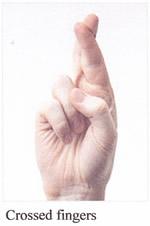January 9, 2026 - Have you ever felt the need for good luck, courage, or protection when attempting to do something? Perhaps you have “crossed your fingers” as a silent request for divine help or protection, or maybe you have asked other people to “keep your fingers crossed.” Some people, mostly children, also use the gesture to excuse their telling a white lie, or to invalidate a promise made. Crossing the first two fingers on your hand is a good luck sign recognized around the world.
 Crossing the fingers dates back to pre-Christian times when the cross was a symbol of unity and benign spirits dwelt at the intersection point. A wish made on a cross was a way of “anchoring” the wish at the intersection of the cross until the wish was fulfilled.
Crossing the fingers dates back to pre-Christian times when the cross was a symbol of unity and benign spirits dwelt at the intersection point. A wish made on a cross was a way of “anchoring” the wish at the intersection of the cross until the wish was fulfilled.
This superstition was popular among early European cultures. It originally took two people. A comrade, or well-wisher, placing his index finger over the index finger of the person making the wish, the two fingers forming a cross. The one person makes the wish, the other empathizes and supports.
However, over the centuries, the custom was simplified so that a person could wish on his own by crossing his index and middle fingers to form an X. Friends crossing fingers evolved to crossing one’s own fingers, and ultimately to the phrase, “Keep your fingers crossed,” with no actual finger-crossing at all.
Crossing the fingers has also been associated with the early Church when Christians would cross their fingers in order to invoke the power associated with the Christian cross for protection when faced with evil. In the early days when Christians were persecuted by the Romans, the Christian used the symbol of crossed fingers, along with the Ichthys (fish), in order to recognize one another and assemble for worship services.
The origin of why fingers are crossed to indicate that we are lying – and negate the negative connotations of lying (justify the lie) is rather murky in terms of any real evidence. It’s generally thought that this “get out of jail free” trick may very well have roots in Christianity, the same as crossing your fingers for luck. One of the Ten Commandments is “do not testify falsely against your neighbor”, or put simply, do not lie. It is speculated that Christians started making the cross symbol with their fingers when lying to protect themselves against God’s wrath for breaking one of the commandments. Sometimes Christians would have to lie about being a Christian since the religion was outlawed under the penalty of death.
Another theory is that crossing your fingers when lying evolved from crossing your fingers for luck. In this case, you would be silently asking for luck in getting away with the lie.
Here is something else that you can do with crossed fingers: The Aristotle Illusion. Have you ever hear of it? You cross your fingers, and then touch a small spherical object, such as a dried pea, and it feels like you are touching two peas. This also works if you touch your nose.
This is an example of what is called “perceptual disjunction”. It arises because your brain has failed to take into account that you have crossed your fingers. Because the pea (or nose) touches the outside of both fingers at the same time – something that rarely happens – your brain interprets it as two separate objects.
In 16th century England, people continued to cross fingers, or make the sign of the cross, in order to ward off evil, as well as when people coughed or sneezed. A book filled with local proverbs published in 1787 records the recommendation to keep one’s fingers crossed until one sees a dog to avert the bad luck attracted to walking under a ladder.
In fiction, the crossed fingers are used by characters when telling lies in order to invalidate promises. An example of this usage is in the film “The Truman Show.” The main character, Truman, realizes his marriage is a farce when he discovers a wedding photo of his wife with her fingers crossed.
Guys, better check your wedding photos very carefully. You might find some crossed fingers.








